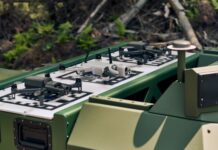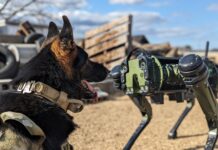Urban warfare is a distinct and vital subset of combat operations. To enhance both lethality and survivability, combat units require equipment tailored to the special challenges of this environment.
Urban terrain is generally presumed to favour the defender. Intact buildings and rubble provide concealment and every corner, doorway, container represents a potential ambush. Likewise, every window and rooftop offer a potential surveillance post, tracking a dismounted attacker’s progress. Winding streets become a maze, threatening disorientation at best, drawing soldiers into killing zones at worst. The first requirement for units entering urban terrain is to gain situational awareness through surveillance and reconnaissance. Moving forward to make contact with the enemy, soldiers in urban environments encounter not only the standard spectrum of physical threats from conventional weapons, but some additional dangers as well. Weapons choices need to be adjusted to the operational environment. Both defenders and attackers must contend with the special aspects of urban warfare, and can adapt tactics and equipment to take advantage of environmental conditions.
Sensors and reconnaissance
Small robotic systems – especially those designed to mimic the range of motion of animals – are well-suited to gathering intelligence within structures, from intact or ruined buildings to tunnels and sewers. Advantages include being able to access constricted areas unsuitable to humans, as well as reducing soldier exposure to deliberate or natural traps.
Black Hornet
Since its introduction in 2012, the Black Hornet Personal Reconnaissance System (PRS) produced (since 2016) by Teledyne FLIR Defense has been acquired by the armed forces of nearly 45 countries, including numerous NATO members. The nano unmanned aerial vehicle (UAV) is controlled via a tablet-sized device, with sensor data relayed wirelessly to the operator. The camera-based navigation system permits operation in GPS-denied indoor and subterranean environments, while the small size and single-rotor configuration minimise both the visual and acoustic signature.
The Black Hornet 3 (BH3) was presented in 2018, and immediately acquired by the US Army for the Soldier-Borne Sensor (SBS) programme, with the intent of outfitting every infantry squad. Following introduction of the new Black Hornet 4 (BH4) variant in 2023, the US Army issued a USD 91 million contract for its acquisition under SBS Phase II. The German Army announced it had signed a contract to procure BH3s and BH4s in January 2025, while the UK and Norway have trialled the BH4.
![The Black Hornet 4 nano-UAV. [Teledyne FLIR]](https://euro-sd.com/wp-content/uploads/2025/11/BH4_handheld-scaled-Kopie-1024x577.jpg)
Robotic ‘Dogs’
Various configurations of ground robots are also being used or evaluated as support tools for dismounted infantry in urban settings. One particularly conspicuous concept is the ‘robotic dog’, officially referred to as a quadruped unmanned ground vehicle (Q-UGV). The low-slung, four-legged design is well suited to mimicking the motion range of a canine, including navigating inclines and stairs, as well as climbing over or slipping under obstacles. Q-UGVs are designed for reconnaissance, surveillance, explosive detection, and for conducting patrols in high-risk environments including buildings, ruins and tunnels. They can operate via remote control or semi-autonomously, transmitting real time tactical data back to operators.
The US Army has been evaluating the Vision 60 Q-UGV developed by Ghost Robotics, and even presented it at the military parade in Washington DC on 14 June 2025 to illustrate the future force. The Vision 60 walks at 3 km/h and runs at 11 km/h. It can be equipped with LIDAR sensors (to map out a 3D image of their environment and assess potential dangers), day/night cameras, chemical and radiological detectors and secure communication modules; future options could hypothetically include weapon payloads.
![A US-Army Vision 60 Q-UGV built by Ghost Robotics participated in the 14 June 2025 military parade in Washington DC. [US DoD]](https://euro-sd.com/wp-content/uploads/2025/11/US-Army-Q-UGV-Kopie-1024x683.jpg)
Wall-penetrating radar
Wall-penetrating sensors offer an additional situational awareness tool capable of locating stationary and moving personnel inside a structure. Camero-Tech Ltd markets the Xaver family of ultra-wideband radar systems which provide dismounted forces the ability to assess the tactical situation before attempting entry; alternatively, they can help forces positioned within a windowless structure to follow movements and threats immediately outside their location. The firm currently offers five systems suitable for urban operations. As described by Camero, the devices use patented image reconstruction algorithms to differentiate targets within cluttered environments, “resulting in a high quality and intuitive image”.
The smallest unit is the 21.8 × 9.7 × 6.5 cm (LWD) Xaver 100; this handheld unit is placed against a surface, and penetrates most standard construction materials including bricks, reinforced concrete, and adobe. The visual display screen pinpoints the precise location of persons in the targeted room, up to a depth of 20 m. The 37 × 22.5 × 12 cm (LWD) Xaver 400 provides higher resolution. Aside from providing information about room dimensions and major infrastructure elements, it differentiates between inanimate objects and immobile persons by detecting the motion of breathing.
![The Xaver 1000 wall-penetrating radar. [Camero-Tech]](https://euro-sd.com/wp-content/uploads/2025/11/Xaver-1000-Kopie-1024x683.jpg)
Additionally, Camero produces two tripod-mounted Xaver devices designed for stand-off operations. The XLR40 and XLR80 respectively operate at distances of up to 50 or 100 m from the target wall, permitting forces to gain intelligence from safe positions.
Weapons and assault technology
While standard infantry weapons are suitable for most urban warfare scenarios, some additional technology can enhance lethality in this particular setting.
Lethal UAVs
As with reconnaissance and situational awareness, unmanned systems can make significant contributions to dismounted infantry’s urban combat capabilities. Several Israeli firms have pioneered development of small UAVs and loitering munition suited for urban environments.
Elbit Systems introduced the Lanius first-person-view (FPV) quadcopter-type loitering muntion in 2022, followed by the Lanius-X series X20 (indoor) and X200 (outdoor) models in 2025. The original Lanius is operational with the IDF, while the Lanius-X series are configured for the export market.
The original Lanius loitering munition measures 29.4 x 29.4 x 16.7 cm (LWH) and weighs approximately 1.25 kg, making it capable of entering buildings through open or destroyed windows and doors, or other suitable gaps including ventilation systems. The Lanius has a top speed of 72 km/h, and has an endurance of 7 minutes. It carries a 125 g high-explosive payload for lethal strikes, or can alternately be configured with a non-lethal payload. The AI-assisted visual navigation system is GPS-independent; while a low-light camera and integrated illuminator permit operations in dark environments.
The Lanius-X series feature multiple modular payload options, day/night cameras, and are mesh-network enabled for coordinated multi-drone operations. The X20 model is configured for indoor operations, and can carry a 170 g payload, with an endurance of 7 minutes. The X200 model is configured for outdoor operations, and can carry a heavier payload of 270 g, with an endurance of 12 minutes.
![Deploying the Rooster hybrid loitering munition. [Robotican]](https://euro-sd.com/wp-content/uploads/2025/11/ROOSTER-6-Kopie-1024x576.jpg)
Armed fire support UGVs
While dismounted operations enhance mobility and the ability to explore every facet of an urban environment, the lack of escort vehicles limits firepower. One solution being explored by multiple NATO nations is the armed UGV. One of the most intensive evaluations is being conducted by the British Army, which in late 2021 acquired four Rheinmetall Mission Master UGV outfitted with the Rheinmetall Fieldranger Multi remote weapon station (RWS) mounting a 7.62 mm machine gun. Designated the robotic platoon vehicle (RPV), the British Army’s UGVs were integrated into the 2022–2024 Autonomous Warrior experiments which concentrated on evaluating new equipment and tactics for their suitability in urban operations. Missions tested included platoon-level fire support, convoy escort, and overwatch missions in mixed manned-unmanned formations. The UK MoD has not yet published the results of the urban operations experiments involving the RPV.
![British soldiers evaluate an armed Rheinmetall Mission Master UGV as support for dismounted urban operations. [Crown Copyright]](https://euro-sd.com/wp-content/uploads/2025/11/Mission-Master-Kopie-1024x683.jpg)
RGW90
For urban terrain, infantry needs to select shoulder-fired weapons with minimal recoil, backblast, overpressure and noise, to ensure safe operation from within buildings or other enclosed positions. One option is the Recoilless Grenade Weapon (RGW) family produced by Dynamit Nobel Defense GmbH (DND). According to DND, over 18 nations have acquired variants of the RGW system, including the first and primary operator, the German Bundeswehr. The weapon system is available in two calibres, 60 mm (RGW60) and 90 mm (RGW90). Both calibres are available in multiple configurations which are effective against multiple target types, but optimised for specific effects.
The RGW90 ASM (anti-structure munition) is particularly suited for urban operations. The 8.7 kg weapon can be fired from enclosed spaces with a minimum area of 18 m2. It is effective against structural targets including hardened targets and bunkers (double-reinforced concrete), triple brick walls, adobe walls, and ad-hoc defences including wooden and sandbag barriers; additionally it is capable of light armour penetration. The weapon is effective at distances between 20 and 500 m.
![The RGW90 ASM variant is effective against bunkers, conventional buildings, and mobile targets. [DND]](https://euro-sd.com/wp-content/uploads/2025/11/RGW90-ASM-Kopie-1024x687.jpg)
The inevitability of urban operations
Whether small towns or megacities, future wars will disproportionally involve urban operations. According to the 2018 United Nations’ World Urbanization Prospects study, some 55% of the world’s population lived in urban settings, with that figure estimated to rise to 68% by 2050. Similarly, the number of megacities with more than 10 million inhabitants was projected to increase from 33 to 43 between 2018 and 2030. From Mogadishu to Mosul, Western militaries with experience of fighting in extended or densely populated cities have underscored the dangers and difficulties of that environment. The next urban operations are only a question of time. Time NATO and partner nations must use wisely to optimise their equipment for challenges ahead.
Sidney E. Dean




![1-163 attacks Razish at NTC In urban terrain, the defender has the initial advantage in choosing his position. Every rooftop offers the opportunity to seize the high ground. [US Army/Capt Gregory Walsh]](https://euro-sd.com/wp-content/uploads/2025/11/Urban-rooftop-Kopie.jpg)


